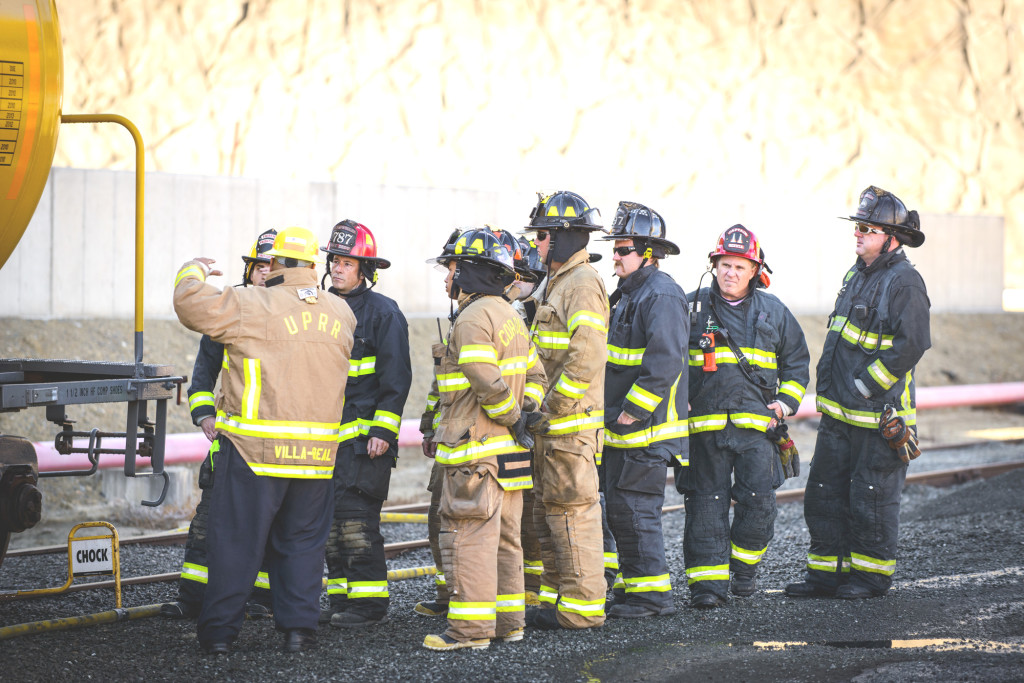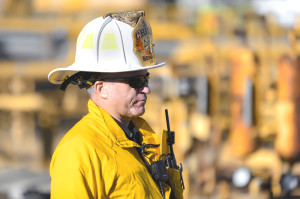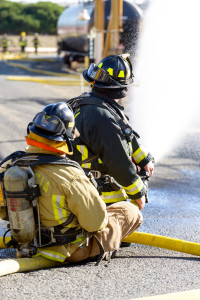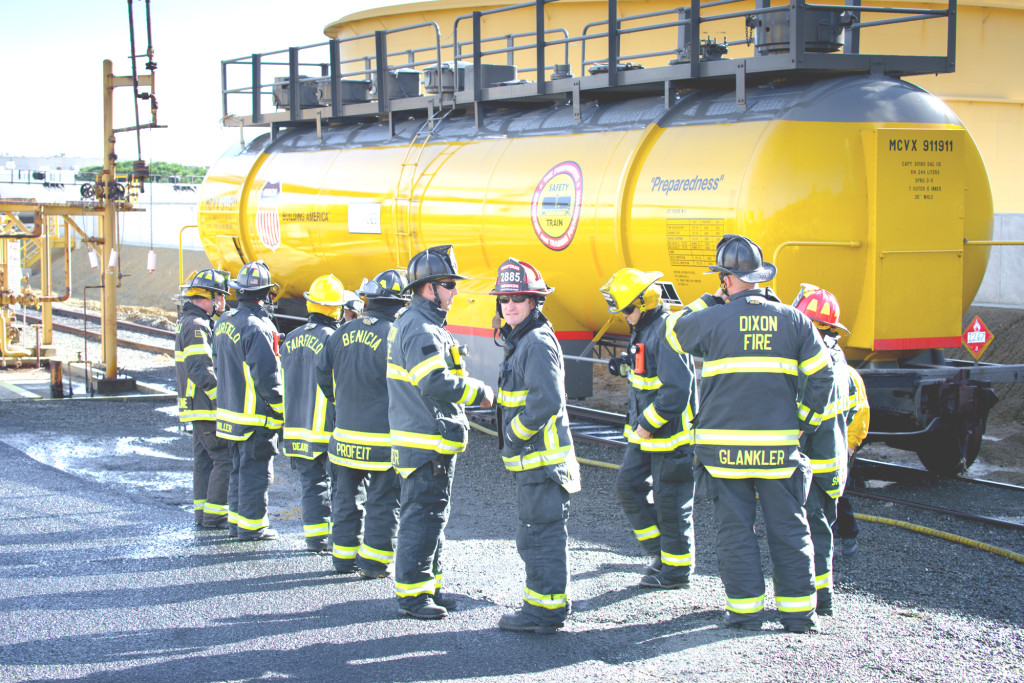Area departments took part last month in Valero-led session on emergency preparedness
Editor’s note: First of two parts. Part two will be published Nov. 11.

FIRE CREWS from various area agencies, including Benicia Fire Department, took part in drills that began Oct. 20.
Mark Losey photo
Fifty of Valero’s own fire department joined 90 municipal firefighters from Benicia, Cordelia, Dixon, Fairfield, Vacaville and Vallejo, as well as Travis Air Force Base, and 20 members of the Solano County Hazardous Materials (Hazmat) Team to the five-day session that began Oct. 20.
Key to the training was a specially built Union Pacific railroad car that from a distance looks like a conventional tank car.
But unlike commercial rail cars, this one has multiple domes and all the valves a firefighter would encounter on the different types of tanker cars that might become damaged or cause a spill in a derailment.
Firefighters routinely train for a variety of emergencies. Valero and Benicia fire departments, both considered “all-risk” departments, have practiced and trained together since the earliest days of the refinery, which was built in 1969 by Humble Oil and bought by Valero in 2000.
“Our efforts at the refinery are to prevent incidents from happening,” said Chris Howe, director of health, safety, environment and government affairs at the refinery. “We handle flammables every day. We have to be prepared.”
Valero’s own 65-member, state-certified fire department is led by Chief Joe Bateman, whose employees train to handle spills, releases and fires. In many cases, Howe said, the employees’ training has exceeded state standards and requirements.
In turn, they’ve been sharing that training with Benicia Fire Department, including paying for six city firefighters to attend classes at Texas A&M Engineering Extension Services Brayton Fire Training Field in College Station, Texas, so they can learn firefighting skills for more intense scenarios.
In local as well as the Texas training sessions, Benicia’s organization has impressed Bateman, the Valero fire chief said in an interview with The Herald Friday, adding that he does “a lot of training at Texas A&M” and teaches there between four and five times a year.
“Benicia is the best I’ve seen,” he said. “They’re one of the most prepared — in their arena and in my arena.”
The five-day local training session with the UP rail car provided practical education not just to Benicia but to other departments, too, Bateman said.
“We’re always prepared here,” he said.
He said the training session took about nine months to plan with the intent it would help other departments reach the same level of preparation and have a chance to work together.
“We’re trying to develop a relationship for large-scale incidents,” Benicia Fire Chief Jim Lydon said.
“We don’t get a large opportunity to work with other departments,” Bateman said. The training, in both firefighting techniques as well as collaboration, will be valuable “in case of an emergency outside our fenceline,” he said.Those instances of cooperation happen more than some people realize, he said.
For instance, during the large Big O Tire fire in Benicia in 2007, Valero equipment and firefighters were on the scene. The refinery fire department also responded to the 6-alarm fire at a Fairfield plastics plant in 2011.
Valero often assists Benicia Fire Department in fighting wildfires, and can vacuum up spent foam so the chemical doesn’t contaminate area waterways.
Like other refineries in the Petrochemical Mutual Aid Organization (PMOA), they often help other refineries or municipalities during a calamity.
The five-day local session was based on a specific scenario, Bateman said. Firefighters were simulating combat of a rail car spill in Fairfield.
Training began with classroom sessions led by Union Pacific Hazardous Materials manager Michael Villa-Real.
The refinery conducted two sessions a day, in which firefighters learned that a strong, deep-penetrating water spray that works on structure fires is not the technique best used in spills.
They practiced switching to nozzles that provide a wider, finer spray better suited for vapor suppression and cooling, because, as Howe explained, what is burning is the vapors, not the liquid.
Then the firefighters introduced fire suppression foam, a concentrate that is combined with water and sprayed through the hoses.
“They trained so they can understand their tools,” Lydon said. Not only did the firefighters learn how to spray and foam a petrochemical fire, they also prepared the barriers that would prevent the foam from entering area waterways.
“The product needs to be held there,” Bateman said.
Union Pacific’s training rail car’s unusual configuration allowed firefighters to practice on a single piece of equipment that had a variety of connections.
Unlike a real tanker rail car, the trainer had doors so firefighters could walk inside and study a tanker’s construction from the inside — a view few get of such a rail car.
They also learned about hazardous materials documentation and how to secure locomotives.
Lydon said departments learned that, as initial responders, they likely would be the first on the scene of a petrochemical incident, and the first-arriving crews need to be able to assess what is happening and start a tactical attack on the spill or fire as they call for mutual aid assistance. That’s also what the other participating fire departments learned, he said.
Union Pacific Railroad regularly helps fire departments and other emergency responders with training sessions, Liisa Lawson Stark, UP director of public affairs, said.“More than 2,400 emergency responders from around the state have completed similar training with UP during the last three years,” Stark said.
After each of the local classes, the presentations and practices were analyzed to determine not only what was learned, but where improvements need to be made, Lydon said.
Valero Benicia Refinery’s fire department already is geared for incidents that could arise on its property, Bateman said.
It has 22,000 gallons of foam on its property; of that, nearly 9,000 gallons of the concentrated chemical is loaded on fire equipment that “can fly out the door.”
Benicia fire trucks are loaded with 30-gallon tanks of their own concentrated foam that expands once it is combined with water, Lydon said.
In addition, he said, Union Pacific, which provides train service to Valero Benicia Refinery, has another 2,000 gallons of foam concentrate in Santa Rosa.
By comparison, the fatal Lac-Megantic derailment July 6, 2013, near Quebec, Canada, took 3,500 gallons of foam to extinguish, and another 2,500 to keep out, Bateman said.
That community, which he compared to Lake Tahoe, “only smaller,” and its volunteer firefighters were overwhelmed and undertrained for the calamity that began when a train was left unattended — something Valero has promised wouldn’t happen should it get city permission to bring in crude oil by trains.
Bateman and Howe said Eric Jacques, superintendent of security and operations at Valero’s Jean Gaulin Refinery in Levis, another city near Quebec, saw the explosion on televised news.
In what they said was a seldom-told sequence of events, Jacques voluntarily redirected an 8,000-gallon tanker from the refinery to battle the resulting explosion.









Excellent article,. That should answer the safety questions. This training shows how serious these departments are in protecting the safety of all area residents. Looking forwarsd to the next part. Thiswshould be mandatory reading for all those in opposition to Crude By Rail.. thank you.
Beyond the oil and rail , firefighters viewpoint—The bigger picture.
More crude-by-rail news the community can use—
More information for our community, citizen -voters and appointed and elected representatives to seriously consider…
“It Could Happen Here: The Exploding Threat of Crude by Rail in California”
“Soda cans on wheels. That’s what some call the dangerous rail tank cars that have suddenly become ubiquitous across the American landscape. In the rush to transport land-locked unconventional new crude oil sources, old rail lines running through communities across America are now rattling with thousands of cars filled with crude oil. Neither the cars nor the railroads were built for this purpose. Worse, federal regulators have few safeguards in place to protect communities and the environment from accidents, spills and explosions resulting from the race to move millions of barrels of crude by rail.”
“More crude oil was transported by rail in North America in 2013 than in the past five years combined, most of it extracted from the Bakken shale of North Dakota and Montana. In California, the increase in crude by rail has been particularly dramatic, from 45,000 barrels in 2009 to 6 million barrels in 2013. As “rolling pipelines” of more than 100 rail cars haul millions of gallons of crude oil through our communities, derailments, oil spills and explosions are becoming all too common. Between March 2013 and May 2014, there were 12 significant oil train derailments in the United States and Canada. As oil companies profit, communities bear the cost.”
“Californians Living Near Crude By Rail Routes”
“A new report from the State of California Interagency Rail Safety Working Group outlines serious vulnerabilities along California rail lines including close proximity to many population centers, numerous earthquake faults, a shortage of adequate emergency response capacity, many areas of vulnerable natural resources, and a number of “high hazard areas” for derailments, which are generally located along waterways and fragile natural resource areas. Millions of Californians live near crude by rail routes and could face extreme safety risks. Currently, there are five major new crude by rail terminals in the planning stages and two recently converted crude oil rail terminals that could collectively bring in up to seven or more mile long trains each day through metropolitan areas like Sacramento, putting up to 3.8 million people in harm’s way.”
http://www.nrdc.org/energy/ca-crude-oil-by-rail.asp
Beyond the oil and rail company executives—The “bigger picture” that these individuals continually seem to ignore—-
More valuable information for our community, citizen -voters and appointed and elected representatives to seriously consider…
Crude-by-rail (profits for the few) vs. Drought and food insecurity (for the many) .
Wake-up Benicia…
“NASA Warns California Drought Could Threaten U.S. Food Supply”
“NASA’s Jet Propulsion Laboratory has sounded a stark warning over California’s sustained drought, publishing its latest findings where satellite surveys show a rapidly depleting groundwater supply.”
“And with California as the United States’ most valuable agricultural state, and thus key to America’s food supply (and much of the world’s as well) that could mean drastic consequences for food commodity prices and potential shortages.”
The Nature Climate Change journal carried the report, which Think Progress summarized:
A new Nature Climate Change piece, “The global groundwater crisis,” by James Famiglietti, a leading hydrologist at the NASA Jet Propulsion Laboratory, warns that “most of the major aquifers in the world’s arid and semi-arid zones, that is, in the dry parts of the world that rely most heavily on groundwater, are experiencing rapid rates of groundwater depletion.”
The groundwater at some of the world’s largest aquifers — in the U.S. High Plains, California’s Central Valley, China, India, and elsewhere — is being pumped out “at far greater rates than it can be naturally replenished.”
The most worrisome fact: “nearly all of these underlie the word’s great agricultural regions and are primarily responsible for their high productivity.”
http://www.globalresearch.ca/nasa-warns-california-drought-could-threaten-u-s-food-supply/5412228
Beyond the oil and rail corporate executives—The “bigger picture” that these individuals continually seem to ignore—-
Below another “small town” election story i.e. more valuable information/news for our community, citizen -voters, city staff and appointed and elected representatives to seriously consider…
“Mendocino County’s Historic Vote Elevates Residents’ Rights, Bans Fracking”
“Mendocino County Becomes First in California to pass a Community Bill of Rights”
“But residents of Mendocino county did far more than ban fracking this election.”
“With the passage of Measure S, residents in Mendocino County made history as the first California community to adopt a Community Bill of Rights, [ placing their rights above corporate interests. Residents see enactment of this ordinance as the first step in asserting their right to local self-government, and a rejection of the idea that their community will be a sacrifice zone for corporate profits.} This is a huge milestone for the community rights movement in California—joining with over 180 communities across the country who have also changed the structure of law by passing rights-based legislation.”
“The Mendocino County Community Bill of Rights Fracking and Water Use Initiative, (Measure S) establishes the rights of the people of Mendocino County to a healthy environment, including clean air and water, and the rights of ecosystems to exist and flourish. The measure also secures the rights of residents to local self-governance. Fracking is banned as a violation of those rights, and directly challenges constitutional so-called “rights” of corporations to frack in their County. The extraction or sale of local water for use in fracking anywhere in the state is also banned, along with the dumping of toxic frack waste. Further, the measure bans the transfer of offshore fracking oil or waste through the County.”
CELDF’s ( Community Environmental Legal Defense Fund) Ben Price offered congratulations to the people of Mendocino County, and to the organizers of the effort, stating, “With this vote, the people of Mendocino are challenging a legal structure that protects a corporate “right” to frack above the rights of communities to not be fracked.”
“Measure S is an important challenge to corporate constitutional rights, and the oil and gas industry. We’re grateful that the voters of Mendocino County so strongly support community rights…Local people deciding for local control and decision making. Democracy won here today!” Jamie Lee echoed this, saying, “this is only the beginning of local self-governance for us up here in Mendocino, the first step of many toward changing the rules about ‘who decides’ what happens here. WE do.”
Fair questions:
What will Benicia do? Should the city council consider a–“Community Bill of Rights Ordinance” for our city? Should this be another page added to our General Plan? Who decides? Ultimately,the citizens of our community should decide what is best for our city —not outside interests, that are based in Houston, Texas.
http://www.globalexchange.org/blogs/peopletopeople/2014/11/05/mendocino-countys-historic-vote-elevates-residents-rights-bans-fracking/
Will you are clueless. There ARE no oil wells in Benicia. tell me about all the oil wells that are in the city’s that have banned fracking. Do you think Kern County will ban frACKING get real Will..
Beyond the oil and rail corporate executives—The “bigger picture” that these individuals continually seem to ignore—-
Below another “small town” election story, i.e. more valuable information/news for our community, citizen -voters, city staff and appointed and elected representatives to seriously consider…
” California Communities Fighting Back Against Prospect Of 25-Fold Crude-By-Rail Increase”
“Ed Ruszel’s workday is a soundtrack of whirling, banging, screeching — the percussion of wood being cut, sanded, and finished. He’s the facility manager for the family business, Ruszel Woodworks. But one sound each day roars above the cacophony of the woodshop: the blast of the train horn as cars cough down the Union Pacific rail line that runs just a few feet from the front of his shop in an industrial park in Benicia, California.”
“But he’s also concerned not just with the kind of cargo, but the sheer volume of it. If a derailment occurs on a train and every single car (up to 100 cars long) is carrying volatile crude, the dangers increase exponentially. The more trains on the tracks, the more likely something could go wrong. In 2013, more crude was spilled in train derailments than in the prior three decades combined, and there were four fiery explosions in North America in a year’s span”
http://www.desmogblog.com/2014/12/13/california-communities-fighting-back-against-prospect-25-fold-crude-rail-increase
Beyond the oil and rail corporate executives—The “bigger community picture” that these individuals continually seem to ignore—-
Below. more valuable information-news from many municipalities about crude-by rail for our community, citizen -voters, city staff and appointed and elected representatives to seriously consider…
Calls to Ban Bomb Trains Ramp Up While Communities Await New Regulations
“Earthjustice has challenged the Department of Transportation’s denial of a petition by Sierra Club and Forest Ethics to ban the transportation of Bakken crude oil in DOT-111 tank cars.”
“The risks are too great to keep shipping explosive Bakken crude in defective DOT-111s. The National Transportation Safety Board called them unsafe two decades ago, and by the Department of Transportation’s own estimates, the U.S. could see 15 rail accidents every year involving these cars until we get them off the tracks.”
“And in California, where last week a train carrying grain derailed into the Feather River, democratic state senator Jerry Hill called on Governor Jerry Brown to impose a moratorium on oil trains in the state. The Feather River rail line is also used for Bakken crude oil trains.”
“As communities across the country await new oil-by-rail regulations and continue to hear about close calls regarding oil train accidents the level of opposition to the dangers of transporting explosive oil in DOT-111s continues to grow. Unfortunately for them, the lobbyists for Big Oil and Big Rail are still hard at work protecting their profits above all else.”
http://www.desmogblog.com/2014/12/15/calls-ban-bomb-trains-ramp-while-communities-await-new-regulations
Beyond the oil and rail corporate executives—The “bigger picture” that these individuals continually seem to ignore—-
Below, more crude-by-rail information/news for our community, citizen -voters, city staff and appointed and elected representatives to seriously consider…
“Oil Trains: Unsafe (and Unnecessary) at Any Speed”
“The immense public risk these oil trains pose is starting to gain the attention it deserves, but not yet the response. Last summer, the U.S. federal government began the process of writing new safety regulations. Industry has weighed in heavily to protect its interest in keeping these trains rolling. The Department of Transportation, disturbingly, seems to be catering to industry’s needs.”
“The current draft rules are deeply flawed and would have little positive impact on safety. They leave the most dangerous cars in service for years. Worse yet, the oil industry would get to more than double its tank car fleet before being required to decommission any of the older, more dangerous DOT-111s.”
http://www.counterpunch.org/2014/12/16/oil-trains-unsafe-and-unnecessary-at-any-speed/